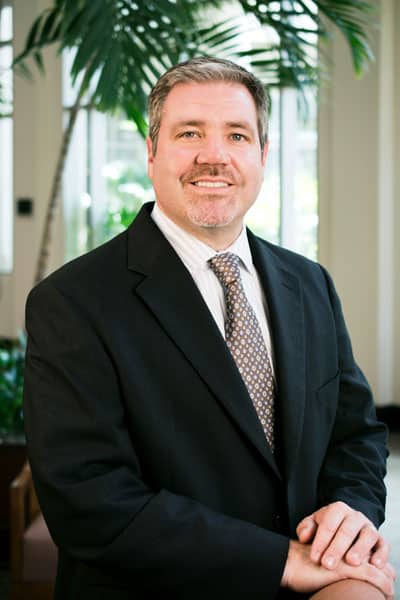When Bennett Cheramie began working as a nurse in the 1990s, healthcare was not a technologically savvy industry. Computer programs were used more by the organization than by clinicians, and clinicians hardly used email. When the health system where Cheramie worked began introducing EMRs and patient scheduling, he volunteered to help the IT department understand operations and train clinicians.
“Originally, we tried just saying, ‘Here’s a technology. Start using it.’ And we failed miserably,” he says. “We realized that, like with most technology, we needed some sort of middleware. That’s really where I found my niche: aligning the operation with technology.”

As Cheramie shifted toward technology, his experience in operations proved invaluable. Now, he’s vice president of information systems at Baton Rouge General Hospital, where he uses technology to streamline clinical processes and individualize patient care.
Visualizing Process
As a former nurse, Cheramie knows that being able to quickly identify patients’ needs is key to keeping the hospital running smoothly. To improve transparency and communication, his team installed screens throughout the hospital that show a map of the nursing units with each room tagged using color-coded symbols.
The same board appears in the emergency department, allowing emergency department nurses to better coordinate with nurses on the floor. When a patient is admitted, an emergency department nurse quickly assesses which room is available based on the screen’s colors.
“When we discharge a patient off the floor, the room on the visualization board turns brown,” Cheramie explains. “That notifies housekeeping to clean the room. Once they’ve cleaned the room, they click the button and it turns green, thus allowing the patient and the nurse in the emergency department to know that the room is ready.”
These automatic updates reduce unnecessary wait times, and patients recognize the change. “It’s exciting to walk through the hospital and see the transport guy picking up the patient and the patient saying, ‘That was fast.’ I know that in the background we have technology powering his work to help him expedite care,” Cheramie says.
With the help of this program, the hospital has improved discharge times by an average of five hours, and they have raised their Hospital Consumer Assessment of Healthcare Providers and Systems scores to the ninetieth percentile. “We’re constantly looking for new adaptive ways that this technology can aid the organization,” he says.
Improving Communication
To further improve communication, Cheramie’s team introduced the secure texting application Imprivata Cortext. With this software, clinicians can send messages from any cellular device or computer directly to a patient or family member’s texting app. For example, a nurse might text a patient’s family member to let them know that the patient is out of surgery and that the surgery was successful. “It’s giving that one personal touch to the patient or the patient’s family when they need it,” Cheramie says.
The system also saves crucial time. Using Imprivata Cortext, the hospital has reduced the time it takes to transfer a patient having an active heart attack from an ambulance into the catheterization laboratory. The hospital aims to complete the process, which includes multiple assessments in the emergency room and preparing the lab, in under ninety minutes.
Previously, clinicians communicated using a variety of technologies, including pagers, landlines, cell phones, and email. “Now, this communication is done through Cortext in a cascade of secure text messages,” Cheramie says. The hospital has dropped the time it takes to get a patient who is having a heart attack into the cath lab to an average of sixty to sixty-five minutes. “Imprivata didn’t do that—our people did that for our patients,” he says. “But the technology helped catalyze the change.”
Unifying Care
After leaving the hospital, patients continue to communicate with Baton Rouge General through the patient portals they use to pay their bills, review their doctor’s office visits, and see information about their hospital stays. Historically, these portals were separate, but this proved challenging for patients. “When you have different electronic medical records or different bill paying systems, it causes a lot of angst,” Cheramie says. “What we are trying to do is create a unified patient portal.”
The hospital has partnered with the company eClinicalWorks, whose platform supports interoperability with most EMR vendors. “Partnering with a company that promotes interoperability is paramount to what we’re trying to do here,” Cheramie says. “If you’re from California and went to the hospital in California, and you moved to Baton Rouge and see the doctor in Baton Rouge, he should be able to access your medical record from California without having to call the hospital in California. It should be easily portable over to this platform.”
Predicting Change
In 2017, Baton Rouge General began implementing artificial intelligence and machine learning technologies to identify and prevent sepsis. Using Wolters Kluwer Health’s clinical intelligence platform POC Advisor, physicians will be able to prevent and treat the life-threatening infection.
POC Advisor’s algorithm assesses physical symptoms, health conditions, and social determinants of health and compares individual patient information with data from healthcare facilities across the country. The system then informs the physician of the patient’s risk of developing sepsis, the factors that contribute to that risk, and a suggested treatment plan.
“This project, I believe, is going to be the model for the future of healthcare at Baton Rouge General, leveraging analytics, machine learning, and clinical decision support,” Cheramie says. “The toughest thing about what we do in developing solutions for healthcare folks is the ability to change, and we’re going to be asking a lot of people to change a lot of things. But it’s all about what’s best for our patients.”

